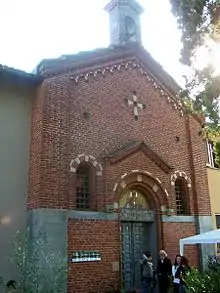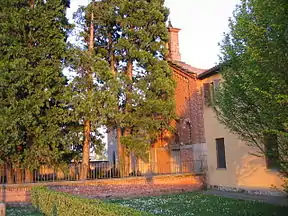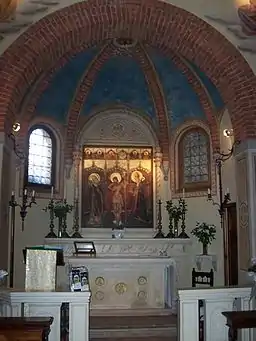Saint Ambrose, Brugherio
Saint Ambrose (Italian: Chiesetta di Sant'Ambrogio) is a small church which is an annex to the farmhouse that takes its name from it, in Brugherio, Italy.
| Saint Ambrose (Chiesetta di Sant'Ambrogio) | |
|---|---|
 Exterior view of the church | |
| Religion | |
| Affiliation | Roman Catholic |
| Province | Monza and Brianza |
| Region | Lombardy |
| Patron | Saint Ambrose |
| Status | Church |
| Location | |
| Municipality | Brugherio |
| State | Italy |
| Architecture | |
| Type | Church |
| Style | Neoromanesque, Gothic |
History
The coenobium and the relics
According to oral[1] and literary sources, in the fourth century, where the church and its farm are now located, there was a villa[2] belonging to the Bishop of Milan, Ambrose. His sister, Marcellina, was consecrated as chaste along with other noble virgins, and Ambrose gave her this land for contemplation and prayer. Ambrose used to retire here to meditate and write. In addition, together with his sister he spread the Christian faith in country villages (pagus in Latin).[3]
Ambrose gave his sister a part of the relics of the three Magi who had been brought to Milan as a gift from the Holy Roman Emperor Frederick I to Bishop Eustorgio. The relics were preserved for centuries[4] and then "found" by Cardinal Federico Borromeo, who moved them to the parish church.[5][6]
16th - 17th century

The religious complex was home to various religious orders: the Benedictines, the Augustinians and the Humiliati.[7] On the site of the present church there was another built during the twelfth century.[8] The Humiliati in 1539 moved to the monastery of Saint Catherine Chiusa of Milano, while maintaining ownership of the monastery.[9] Among the assets of the monastic complex there was a chapel used for prayer mentioned by Cardinal Federico in the report of the pastoral visit of 1596. In it, he describes the precarious architectural state (which prompted a series of restorations undertaken until 1621),[10] and the wealth of the church utensils.[11] The church appears in the maps of the Teresian Cadastre of 1763,[12][13] including a building located along the road to Carugate.[14]
19th century
After the suppression of the monastic orders by Napoleon Bonaparte, the farmhouse and church were sold to various landowners.[15] In 1886 the church was restored and some frescoes of the fourteenth century were found. They depict Saint Ambrose among his brothers Satyr and Marcellina with the holy martyrs Sebastian and Pope Fabian.[16]
20th century
On the occasion of the 1600th anniversary of the velatio[17] of Marcellina, in 1953 the owners of the farm, lords Cavajoni-Bologona, decided to renovate the frescoes and build the lunette on the building's facade. On October 31,[18] Monsignor Ennio Bernasconi, mitred abbot of St. Ambrose of Milan, praised not only Marcellina and his brothers but also the owners responsible for the restoration.[19] Minor restorations were also executed in 1959.[20] Since 2009,[21] the church and the homonymous farmhouse were included in the project "Ville Aperte", a Monza and Brianza province project promote the arts.
Architecture and art
The facade after 1886
The current appearance of the facade dates back to an 1886 restructuring commissioned by the owner, Ercole Gnecchi.[16] It was rebuilt in brick[22] in the style of Lombardy,[23] in reference to the Basilica of Saint Ambrose in Milan, and is divided by a cornice. The top has a central lunette depicting the blessing of Saint Ambrose, surrounded by a round arch, and next to it there are two arched windows.[15] This section is surmounted by a pediment, and above it there is a small tower.[24] The bottom presents a splayed portal. The lintel is the original one, and depicts an early Christian greek cross with the symbols of the evangelists, Mark and John.[15][23]

Interior
The church is characterized by a small nave with apse,[24] covered by a gable in turn supported by wooden trusses with decorated warping.[15] The flooring is made of terracotta brick, while the walls are painted in a light colored parchment, itself decorated with polychrome socket boxes.[24] Preceding the altar there are a round arch and a tympanum above it, which depicts two angels in prayer. In the tympanum there is an oval inside which is enclosed a radial cross termed Salus Mundi.[23][24] The vault of the presbytery is decorated with a blue sky with gold stars.[15] The presbytery contains an altar made of stone, which is separated from the rest of the church by a balustrade in gothic style and in the same material.
1953 restoration
During the restoration in 1953, the team led by Professor Franco Milani[20] found some frescoes dating to the fifteenth century.[20] On the left wall there are depictions of Pope Fabian and Saint Sebastian, while on the right side there are depictions of Saint Ambrose, Marcellina and Satyr.[25] These frescoes were damaged by moisture and covered with layers of lime. The damage was also observed to undermine the pilaster. After restoration the frescoes were partly preserved. Classic iconographic representations of Saint Ambrose are of an old man, but in this church's frescoes both the bishop and Saint Sebastian are represented as young people.[15] The frescoes have a gothic style that also characterizes the altarpiece.[26] The author was probably influenced by artistic trends of northern Europe as well as by Giotto.[27]
References
- Movimento Terza Età. Brugherio. La nostra gente (in Italian). Brugherio.
- "Villa" as Roman word means a land where people rest away from the city
- Biraghi, Luigi (1867). Vita di Santa Marcellina (in Italian).
In this solitude Marcellina and her companions added to prayer, meditation and penitential life, the apostolate of example. In the middle of those fields and in the woods, she fulfilled in an apostolic mission; she preached the same examples of his angelic life and her companions. Call our mind to the fourth century and we think that faith was well-made large purchases in the city and among civilized people, but stubborn and blind idolatry reigned in many parts of the country and in the pages, whence came the name of "pagan" idolaters. Ambrose speaks often of gentle and idol worshipers in Milan and especially in the countryside, like in Rome, and the imperial laws against idolatry, which were not observed. Now as of this darkness will be rained enlivens the light and grace of the holy virgins!
- Movimento Terza Età. Brugherio. La nostra gente (in Italian). Brugherio. p. 11.
- "Brugherio, Chiesa di Sant'Ambrogio e Oratorio di Santa Marcellina" (in Italian). Retrieved 3 March 2015.
- Petrarca, Francesco (1955). "Guido Martellotti – Pier Giorgio Ricci - Enrico Carrara et alii". De vita solitaria. Francesco Petrarca – Prose (in Italian). II. Milano – Napoli: Riccardo Ricciardi Editore. p. 4; 430–433.
- Velatio di Santa Marcellina (in Italian). p. 72.
The nuns, probably Benedictines, in 1450 merged with the Agustinian and the Huliliati.
- Tribuzio Zotti, Luciana; Magni, Giuseppe. Una città nel segno dei Magi (in Italian). p. 68.
- Tribuzio Zotti, Luciana; Mgni, Giuseppe. Una città nel segno dei Magi (in Italian). p. 57.
- Tribuzio Zotti, Luciana; Mgni, Giuseppe. Una città nel segno dei Magi (in Italian). p. 67.
- Tribuzio Zotti, Luciana; Mgni, Giuseppe. Una città nel segno dei Magi (in Italian). pp. 66–67.
- Tribuzio Zotti, Luciana; Mgni, Giuseppe. Una città nel segno dei Magi (in Italian). pp. 67–68.
- In this year Cardinal Giuseppe Pozzobonelli visited the church, too.
- Velatio di Santa Marcellina (in Italian) (2nd ediction ed.). Milano: Edizioni Marcelline. 2013. p. 71.
Ambrose's property, under Carugate's parish before Saint Charles built Brugherio's parish in 1578...
- Porfidio, Vicky (2009). Brugherio: i suoi luoghi, la sua storia (in Italian). Brugherio: Comune di Brugherio. p. 39.
- Sibilla, Anna Maria. Cascina Sant'Ambrogio (in Italian). p. 20.
- "Velatio" stands for the consecration of Marcellina that took place in Rome in 353 by Pope Liberio.
- Sibilla, Anna Maria. Cascina Sant'Ambrogio di Brugherio (in Italian). p. 22.
- Bernasconi, Ennio (1959). Nella villa di campagna di S. Marcellina. Discorsi di Mons. Ennio Bernasconi Abbate Mitrato di S. Ambrogio nell'Oratorio di Sant'Ambrio a Brugherio. p. 13.
- Velatio di Santa Marcellina (in Italian). p. 72.
- "Ville Aperte 2009" (in Italian). Retrieved 3 March 2015.
- Ghezzi, Luigi; Bagnoli, Raffaele. La Cascina Sant'Ambrogio di Brugherio (in Italian).
- Porfidio, Vicky. "Chiesetta di S. Ambrogio" (in Italian). Retrieved 2 March 2015.
- Bernasconi, Ennio. Nella villa di campagna di S. Marcellina. Discorsi di Mons. Ennio Bernasconi Abbate Mitrato di S. Ambrogio nell'Oratorio di Sant'Ambrio a Brugherio (in Italian). p. 32.
- Ghezzi, Luigi; Bagnoli, Raffaele. La Cascina Sant'Ambrogio di Brugherio (in Italian).
- Brugherio: geografia, storia ed economia (in Italian). Brugherio: Comune di Brugherio. p. 255.
- Porfidio, Vicky. Brugherio: i suoi luoghi, la sua storia (in Italian). p. 39.
Bibliography
- Bernasconi, Ennio (1959). Nella villa di campagna di S. Marcellina. Discorsi di Mons. Ennio Bernasconi Abbate Mitrato di S. Ambrogio nell'Oratorio di Sant'Ambrio a Brugherio (in Italian).
- Biraghi, Luigi (1867). Vita di Santa Marcellina (in Italian).
- Brugherio: geografia, storia ed economia (in Italian).
- Ghezzi, Luigi; Bagnoli, Raffaele (1942). La Cascina Sant'Ambrogio di Brugherio (in Italian). Milano: Tipografia delle Mission.
- Movimento Terza Età (1992). Brugherio. La nostra gente (in Italian). Brugherio.
- Petrarca, Francesco. De vita solitaria (in Italian). II. pp. 430–433. in Martellotti, Guido; Ricci, Pier Giorgio; Carrara, Enrico (1995). Francesco Petrarca - Prose (in Italian). Milano - Napoli: Riccardo Ricciardi Editore.
- Tribuzio, Zotti (1989). Brugherio. Luoghi memorabili (in Italian). Brugherio: Edizioni Parole Nuove.
- Tribuzio Zotti, Luciana; Magni, Giuseppe (2012). Una città nel segno dei Magi: Brugherio 1613-2013 (in Italian). Brugherio: Associazione Kairòs.
- Sibilla, Anna Maria. La Cascina Sant'Ambrogio (in Italian).
- Suore Marcelline (2013). Velatio di Santa Marcellina (in Italian). Milano: Edizioni Marcelline.
External links
| Wikimedia Commons has media related to Sant'Ambrogio (Brugherio). |
- "LA CASCINA SANT'AMBROGIO DI BRUGHERIO". http://www.cascinasantambrogio.com/ (in Italian). External link in
|website=(help) - Porfidio, Vicky. "Chiesetta di S. Ambrogio". http://www.meetbrianzaexpo.it/ (in Italian). External link in
|website=(help) - Gibelli, Silvia. "Chiesa di S. Ambrogio". http://www.lombardiabeniculturali.it/ (in Italian). Retrieved 19 September 2014. External link in
|website=(help) - "Brugherio, Chiesa di Sant'Ambrogio e Oratorio di Santa Marcellina". http://www.romanicobrianza.it/home/ (in Italian). External link in
|website=(help) - "Ville Aperte 2009". http://www.provincia.mb.it/index.html (in Italian). External link in
|website=(help)